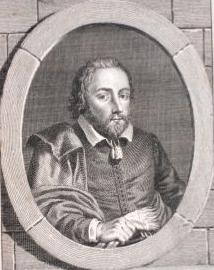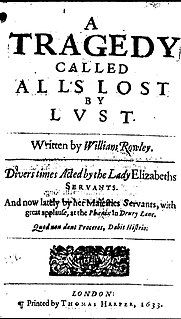Related Research Articles

Galerius Valerius Maximinus Daza, also known as Daza, was Roman emperor from 310 to 313 CE. He became embroiled in the Civil wars of the Tetrarchy between rival claimants for control of the empire, in which he was defeated by Licinius. A committed pagan, he engaged in one of the last persecutions of Christians, before issuing an edict of tolerance near his death.

Philip Massinger was an English dramatist. His finely plotted plays, including A New Way to Pay Old Debts, The City Madam, and The Roman Actor, are noted for their satire and realism, and their political and social themes.
This article contains information about the literary events and publications of 1622.
William Rowley was an English Jacobean dramatist, best known for works written in collaboration with more successful writers. His date of birth is estimated to have been c. 1585; he was buried on 11 February 1626 in the graveyard of St James's, Clerkenwell in north London.
William Haughton was an English playwright in the age of English Renaissance theatre.

The Shakespeare apocrypha is a group of plays and poems that have sometimes been attributed to William Shakespeare, but whose attribution is questionable for various reasons. The issue is separate from the debate on Shakespearean authorship, which addresses the authorship of the works traditionally attributed to Shakespeare.
The Birth of Merlin, or, The Child Hath Found his Father is a Jacobean play, probably written in whole or part by William Rowley. It was first performed in 1622 at the Curtain Theatre in Shoreditch. It contains a comic depiction of the birth of the fully grown Merlin to a country girl, and also features figures from Arthurian legend, including Uther Pendragon, Vortigern, and Aurelius Ambrosius.

Saint Winifred was a Welsh virgin martyr of the 7th century. Her story was celebrated as early as the 8th century, but became popular in England in the 12th, when her hagiography was first written down.

Saints Crispin and Crispinian are the Christian patron saints of cobblers, curriers, tanners, and leather workers. They were beheaded during the reign of Diocletian; the date of their execution is given as 25 October 285 or 286.

All's Lost by Lust is a Jacobean tragedy by William Rowley. A "tragedy of remarkable frankness and effectiveness," "crude and fierce," it was written between 1618 and 1620.

The Diocletianic or Great Persecution was the last and most severe persecution of Christians in the Roman Empire. In 303, the emperors Diocletian, Maximian, Galerius, and Constantius issued a series of edicts rescinding Christians' legal rights and demanding that they comply with traditional religious practices. Later edicts targeted the clergy and demanded universal sacrifice, ordering all inhabitants to sacrifice to the gods. The persecution varied in intensity across the empire—weakest in Gaul and Britain, where only the first edict was applied, and strongest in the Eastern provinces. Persecutory laws were nullified by different emperors at different times, but Constantine and Licinius' Edict of Milan in 313 has traditionally marked the end of the persecution.

The Shoemaker's Holiday or the Gentle Craft is an Elizabethan play written by Thomas Dekker. The play was first performed in 1599 by the Admiral's Men, and it falls into the subgenre of city comedy. The story features three subplots: an inter-class romance between a citizen of London and an aristocrat, the ascension of shoemaker Simon Eyre to Lord Mayor of London, and a romance between a gentleman and a shoemaker's wife, whose husband appears to have died in the wars with France.
The Spanish Gypsy is an English Jacobean tragicomedy, dating from around 1623. The play was likely a collaboration between several dramatists, including Thomas Middleton, William Rowley, Thomas Dekker, and John Ford. Like Shakespeare's lost play Cardenio, The Spanish Gypsy is an English reworking of the novellas of Miguel de Cervantes, combining two of Cervantes' Novelas Ejemplares into a single drama.
Wit at Several Weapons is a seventeenth-century comedy of uncertain date and authorship.

Blurt, Master Constable is a late Elizabethan comedy, interesting for the authorship problem it presents.
The Virgin Martyr is a Jacobean era stage play, a tragedy written by Thomas Dekker and Philip Massinger, and first published in 1622. It constitutes a rare instance in Massinger's canon in which he collaborated with a member of the previous generation of English Renaissance dramatists – those who began their careers in the 1590s, the generation of Shakespeare, Lyly, Marlowe and Peele.
The Queen's Exchange is a Caroline era stage play, a tragicomedy written by Richard Brome.
A Match at Midnight is a Jacobean era stage play first printed in 1633, a comedy that represents a stubborn and persistent authorship problem in English Renaissance drama.
A New Wonder, a Woman Never Vexed is a Jacobean era stage play, often classified as a city comedy. Its authorship was traditionally attributed to William Rowley, though modern scholarship has questioned Rowley's sole authorship; Thomas Heywood and George Wilkins have been proposed as possible contributors.
The Noble Spanish Soldier (1622) is a Jacobean play written by English author Thomas Dekker.
References
- ↑ William Rowley, All's Lost by Lust, and A Shoemaker, a Gentleman, edited by C. W. Stork, University of Pennsylvania Publications, Philology and Literature, vol. XIII, Philadelphia, John C. Winston Co., 1910; William Rowley, A Shoemaker a Gentleman, edited by Trudy Laura Darby, London, Globe Quartos, Nick Hern Books, 2002.
- ↑ E. K. Chambers, The Elizabethan Stage, 4 Volumes, Oxford, Clarendon Press, 1923; Vol. 3, p. 473.
- ↑ Stanley Wells, "William Rowley and The Golden Legend," Notes and Queries 6 (1959), pp. 129–30; Gina M. Di Salvo, "Saints' Lives and Shoemakers' Holidays: The Gentle Craft and the Wells Cordwainers' Pageant of 1613", Early Theatre 19 (2016), pp. 119–138.
- ↑ Terence P. Logan and Denzell S. Smith, eds., The Popular School: A Survey and Bibliography of Recent Studies in English Renaissance Drama, Lincoln, NE, University of Nebraska Press, 1975; p. 11.
- ↑ Mark Dominik, William Shakespeare and "The Birth of Merlin," Beaverton, OR, Alioth Press, 1991; pp. 32–3 and ff.
- ↑ Alexander Leggatt, Jacobean Public Drama, London, Routledge, 1992; pp. 51, 57, 65, 70 and ff.
- ↑ Arthur Percival, The Faversham Legends of Crispin and Crispianus, Princes and Saints, Faversham Papers No. 73, Faversham Society, 1999